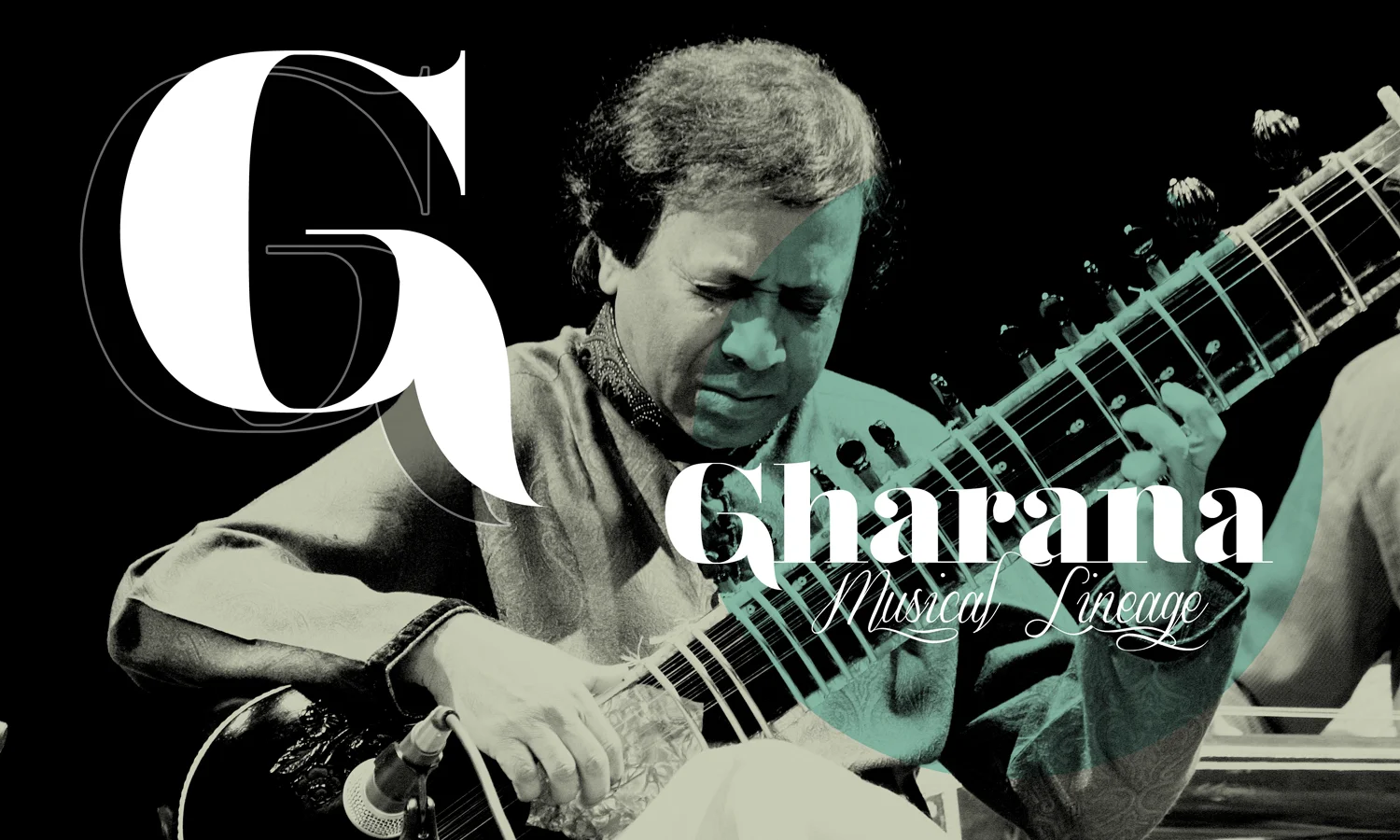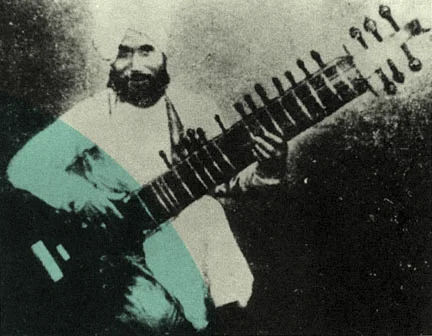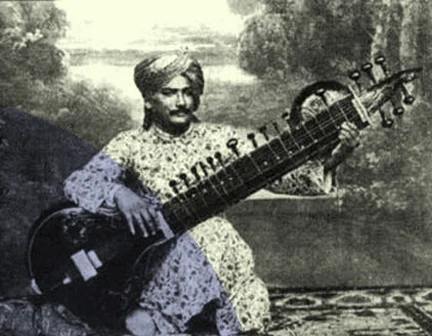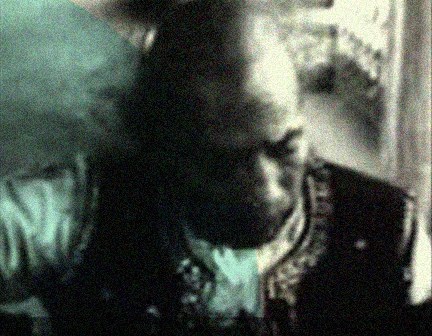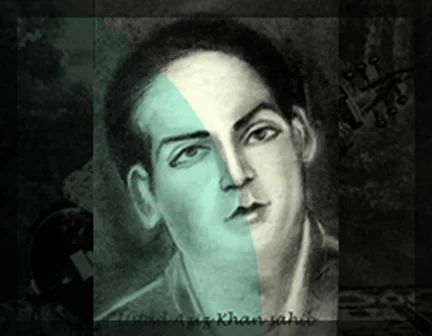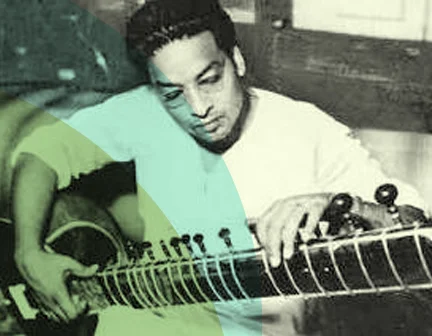Etawah Gharana
This style comes from of the most ancient school of music, the Gwalior gharana. It is also known as the Imdadkhani gharana after Ustad Imdad Khan, the son of Ustad Sahebdad Khan. Ustad Sahebdad Khan was trained and influenced by Ustad Haddu and Ustad Hassu Khan of the Gwalior gharana, and thus dhrupad and khayal vocal genres can be glimpsed in the playing style and in the choice of ragas. To the techniques of Been and Rebab many new techniques have been added.Ustad Imdad Khan and his sons Ustad Inayat Khan and Ustad Wahid Khan made this gharana famous. Ustad Vilayat Khan, son of Ustad Inayat Khan, furthur developed his father and uncle's handling of midh and murki. He also modified the structure of Sitar.
Based on the classical structure of the raga, this gharana includes alap, jor and jhala (slow then accelerating improvisation) without percussion as it is played in dhrupad, followed by the khayal composition called Gat, with the tabla, developed in numerous improvisations on rhythm and note like tans and layakaris *
USTAD IMDAD KHAN
Instrumental in developing the unique style that characterizes the Etawah Gharana, Ustad Imdad Khan was one of the most influential instrumentalists of Indian Classical Music. He helped to establish the Etawah Gharana, which is also known as the Imdadkhani Gharana.
Ustad Imdad Khan was born into a musical family. His father was Ustad Sahabdab Khan, the founder of the Etawah Gharana.
Ustad Sahabdab Khan was a close relative of Ustad Haddu Khan of Gwalior Gharana. Initially Sahabdab Khan was taught khayal vocals by Ustad Haddu Khan, but later took up Sitar. He later moved to Etawah, from which the gharana’s name is derived.
Although Ustad Sahabdab Khan was the founder of the gharana, It was Ustad Imdad Khan who developed the instruments, and created an innovative instrumental style that became characteristic of the gharana. Imdad Khan heard and studied the contemporary styles of various stalwarts of music of his time. He then developed an original style, one that was radically different from the then prevalent Senia style for playing the surbahar and sitar, thus ushering in a new era.
Ustad Imdad Khan introduced elements of khayal gayaki into the alap for the first time. All gayaki ornamentations were implemented and systematically developed into the techniques for this newly developed style for playing sitar. All khayal taans, tabla and pakhawaj bols, and the numerous rhythmic variations and subdivisions of the tempo were interspersed, strengthening the interaction of the swara and the laya. Jhala and thok jhala were introduced as separate sections. A definite sequence was brought into playing the gat toda, and the composition of exciting todas with matching tihais added new grandeur to a sitar recital. This new style that was to gain in popularity throughout the 19th and 20th centuries, and that continues to flourish with proponents like Ustad Shahid Parvez Khan, has come to be known as Imdadkhani.
Commissioned by Mysore kings in whose courts he served, Ustad Imdad Khan became the first Sitar player to come out with a recording. RPG / EMI has brought out those timeless recordings in a two CD album. Chairman's Choice - Great Gharana - Imdadkhani (CMC 882507-08).
Ustad Imdad Khan had two sons, Ustad Enayet Khan and Ustad Waheed Khan who took up Sitar and Surbahar
USTAD ENAYET KHAN
Ustad Enayet Khan was a master of Sitar and Surbahar. He developed the 'Gayaki Ang' in sitar, which his father had developed for the surbahar and his sons would further develop this, which would come to be known as a trademark of their gharana.
He gave a new dimension to the crafting and manufacture of the sitar and his structural modifications of the instrument are still used in the instruments of today whilst his musical contributions are standardized practice for today's musicians. The flair with which he played made him one of the greatest musicians of his generation and his legendary recordings illustrate and record the contributions he has made to music. Ustad Enayet Khan was a great ambassador for Indian classical music in India. He popularized the sitar and made it accessible for the general population. This was a time when many of the famous Indian music festivals were started. His music was the soul of India in those times of change and he had a great and unrivalled following throughout the country. This contribution to popular arts and culture can be illustrated by his friendship with Rabindranath Tagore, the legendary writer, artist and poet. Together these two giants of culture put poetry to music to bring it alive in some of the most famous Indian folk songs and anthems. Each inspired the other to take the arts of India to dizzying new heights.
Ustad Enayet Khan dedicated his life to music; He played, taught and lived with an equal passion to strengthen the name of his gharana and the profile of classical music in his country.
USTAD Waheed Khan
One of the greatest musicians in the canon of Indian Classical Music, Ustad Waheed Khan is an important figure in the Etawah gharana’s history.
An acclaimed musician on both the sitar and surbahar, Waheed Khan’s life’s purpose was to be a herald for Indian Classical Music. He devoted his life to spreading his music everywhere. Living his life modestly, he made his home in different parts of India for brief periods of time, spreading the innovative style of his gharana with unwavering devotion and elegance. One such initiative included an appearance in legendary filmmaker Satyajit Ray’s “Jalsaghar” (The Music Room,1958) where Ustad Waheed Khan performs on the surbahar in one of the scenes.
A true emissary, he lived well into his 70s and his immense contribution to Indian Classical Music was recognized when he became the first musician to receive the illustrious “Sangeet Natak Academy Award”—the highest national recognition given to performing artists in India.
He was the father of Ustad Aziz Khan and Ustad Hafeez Khan. Ustad Hafeez Khan was a celebrated playback singer, known in the film industry as 'H. Khan Mastana'.
His brother, Ustad Aziz Khan would also carry on the family’s musical traditions and go on to make significant contributions to Indian Classical Music.
USTAD AZIZ KHAN
Ustad Aziz Khan is the youngest son of sitar and surbahar maestro Ustad Waheed Khansaab. The young Gunna Bhai, as Aziz Khansaab was lovingly addressed by his family members, was introduced to music at a very young age and as years passed by he received extensive “taleem” (lessons) in the music of the gharana from his lengendary Guru and father Ustad Waheed Khansaab, in vocal music, sitar and surbahar. He also received some taleem from his equally legendary uncle Ustad Enayat Khansaab.Although his repertoire of traditional taleem was highly enviable, he did not take up sitar or surbahar as a source of lively hood. Instead, he took up music – composition as his profession. However, he never left his “sadana” that is music and performed in occasional concerts from time to time. He became a professional music composer in the Bollywood film industry composing under the pseudonym Aziz-Hindi.
Even here his musical talents came to the fore. He enjoyed considerable success while composing for films like “Intezar ke bad,” “parvartan -1949,” “Putli - 1950,” “Actor 1952,” “Thoop Chaon – 1954,” “Danka –1954,” “Chalta Poorza – 1958.”
Ustad Aziz Khan also composed music for several other films in partnership with another lyricist and composer, Khaiyyam. In these films, they use to call themselves “Sharma ji – Varma ji.” The very first film that they composed for was a huge hit called “Heer- Ranjha”. A few other films for which the “Sharma ji - Varma ji” duo composed music were “Parda,” “Biwi,” “Pyar ki batein,” etc, which were all musical hits. However, no matter how good he was as a composer or how famous he became as a composer, Aziz Khansaab’s taking up music as a profession did not go down well with his father.
Ustad Waheed Khansaab was of the idea that a “gharanadar” and “khandani” musician, who has received so much taleem, must earn his bread through “mujlishs” (concerts) only and not through any other means.
Ustad Waheed Khansaad made his displeasure known to his sons and told that he could only be pleased if and only if, he was assured that his grandchild would be trained in the music of the gharana and his grandchild would pick up sitar or surbahar as his profession, so that his grandchild could one day go on to become the torchbearer of the Etawah Gharana.
In fact, after this incident, Ustad Aziz Khan’s life long quest was to train his son. He was demanding and very strict as a Guru. He would often say to his son, the young Shahid Parvez, - “I want you to play like this and I will make you play like this, no matter what it takes.” Often the Ustad’s wife would bring in food and he would forget about the food and go on teaching his son oblivious of the fact that his son would also be hungry. Ustad Aziz Khan Saab was a very hounest man. He didn’t believe in taking students for the sake of it or just to increase the numbers. However, he had quite a few students other than his foremost disciple and son Shahid Parvez Khan; and whoever was fortunate enough to receive his blessings as a student, has become established as a musician in his life. He was very strict but even more honest as a Guru.
However, those that have listened to his sitar or surbahar or to the songs that he has composed will know that Ustad Aziz Khansaab was a true artist; and music was the love of his life.
Ustad Vilayat Khan
Ustad Vilayat Khan stands out as one of the greatest sitar players of all time. He was born in year 1928 in the village of Gauripur (present day Bangladesh). During his lifetime, he became one of the most influential musicians of Indian Classical Music.
*adapted from Musicalnirvana.com
Several people influenced Khan sahib's music. Ustad Enayet Khan, his father, Ustad Waheed Khan, his uncle, Ustad Zinda Hussain Khan, his maternal uncle, Ustad Faiyaz Khan and Ustad Abdul Karim Khan deserve special mention in this regard. He developed the "Gayaki Ang" which became his trademark. Khan sahib made several changes to the structure of the sitar and these include the concept of "Gol Jawari".Ustad Vilayat Khan's professional career was extensive. He made several international tours, he has numerous recordings, and has scored music for several films, including Satyajit Ray's "Jalsaghar".
He was a longtime critic of the political machinations that were behind the awarding of many of India's honours. He refused the Padmabhushan (one of India's top civilian honours), and was a longtime critic of the manner in which All India Radio was run. The only title that he ever embraced was the title Aftab-e-Sitar (Sun of Sitar).
Ustad Vilayat Khan died of lung cancer at the Jaslok Hospital in Mumbai on March 13th, 2004. He was 76 years of age.
